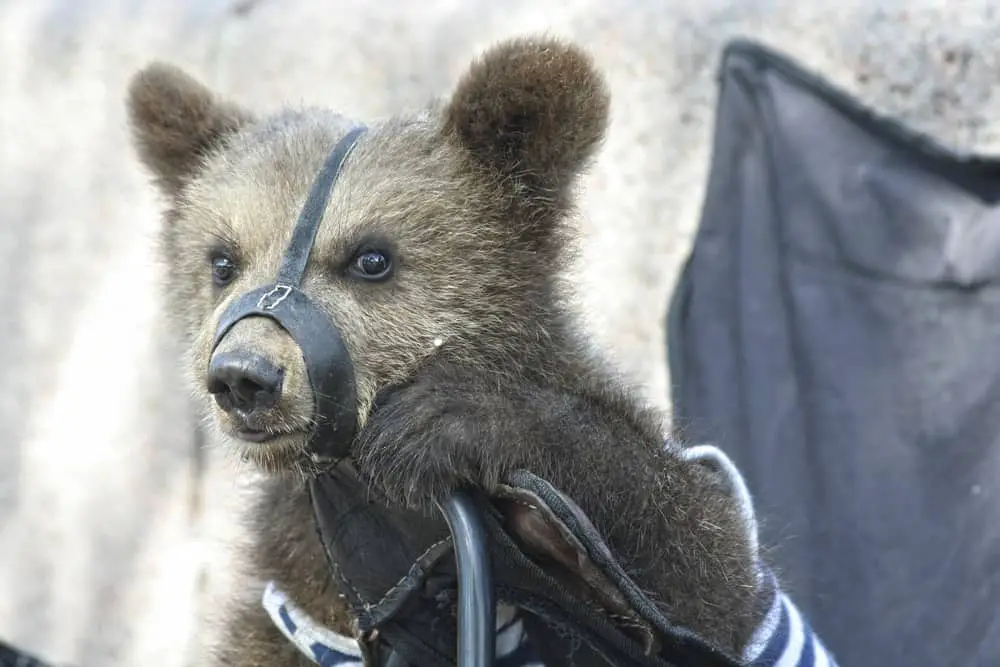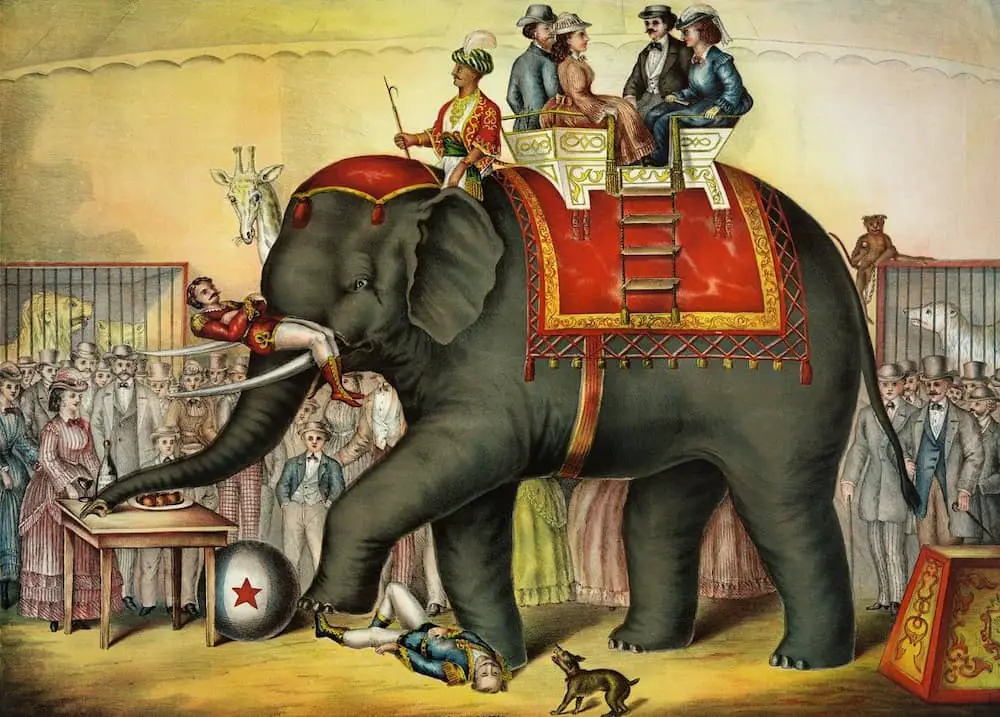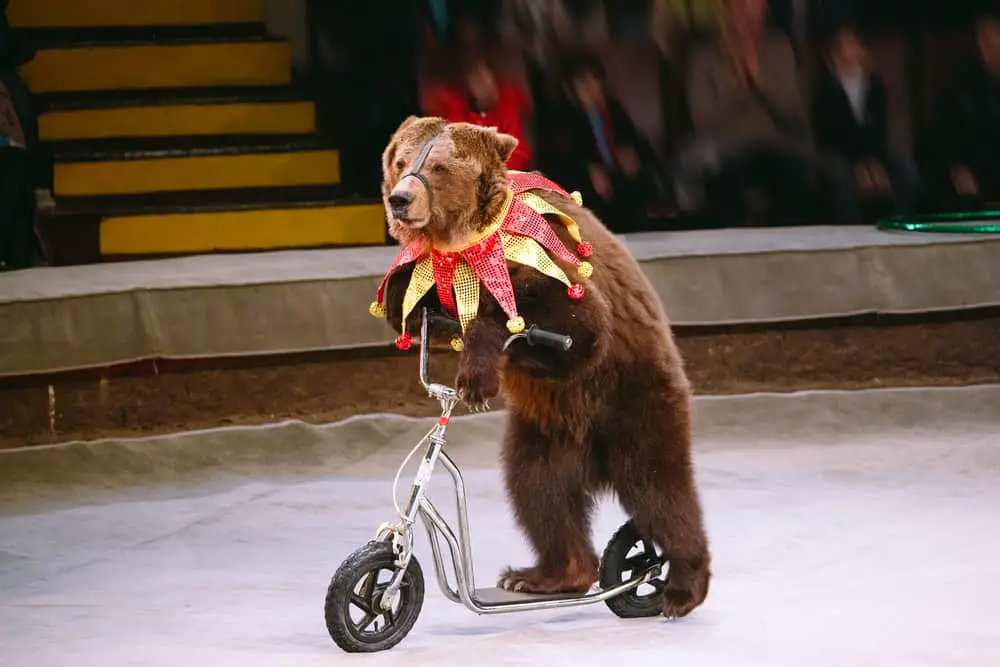Since the first circuses that involved animals, millions have sat and watched in pure awe and joy as people rode decorated and talented elephants, bears balanced on wires and rode unicycles, lions and tigers followed orders and performed tricks like well-trained house pets.
But have you ever thought of how cruel this form of entertainment is?
Circuses are cruel to animals. In circuses, animals stay in cramped cages, they are overworked and undernourished. Animals are also beaten into submission and their horrible living conditions lead to early deaths – often by illnesses not found in their natural habitats.
Animals were introduced into circuses in 1851 and have suffered at the hands of their owners ever since.
These animals are used purely as tools to be exploited for money. Audiences may not realize how cruel their entertainment is. We’re going to dive into that right here.
Circuses Are Cruel to Performance Animals
Anyone in a circus audience has the rare opportunity to encounter animals they may never see in their lifetime. From bears to elephants to lions – you get the chance to see these majestic creatures up close and personal at the circus.
But it comes at a cruel price that leaves most people in blinding shock. The horrifying truth lying under the big top is that circuses subject their animals to severe cruelty.
Below are some examples of how circuses are cruel and abusive to the animals they use in their shows. Many of these practices have led to animals attacking people out of sheer terror and survival instinct.
Circus animals:
Small Containments
Tigers and lions, for example, are often kept in cages that are far too small, whether they are traveling or between acts. For these big cats to be contained safely, they would need almost eight square miles to run, hunt, play, and release energy.
However, the typical size of a lion or tiger cage where circus animals spend their time is four by eight feet. Simply put, these cages are not suitable at all.
Bigger animals, like elephants, require acres upon acres of land – at least 100 – for roaming, playing, socializing, eating, and exploring. However, they will never experience any of that when they are forced to perform tricks in a circus.
When they are not performing, these naturally playful and curious animals are kept in cages. They are not enriched whatsoever in their tiny homes. Playing with even a log or some small toy is not allowed for fear that they will escape.
More often than not animals end up standing and laying in their own excrement. Leading to open wounds that are more susceptible to infection and illness.
Physical Abuse
Circus employees use the most obvious and brutal form of training to subdue wild animals: physical abuse.
Beatings
Trainers use various instruments to get exotic animals to perform tricks. Including (but not limited to) whips, whips with razors, bull hooks, broom handles, and electric rods. The objective is to dominate the animals and force them into submission.
Cages and Shackles
When they are not training or performing, the circus animals are shackled and caged. There, they develop sores and pressure wounds from laying on hard surfaces for long periods.
Trainers beat these animals during training and also when they do not perform a trick or act correctly. Often, they are held in cages and chained in their off-time or when they are traveling. Which can be up to 11 months in any given year.
Force Fed Drugs
Not only are these animals physically abused with beatings and other such torture. They are also force-fed drugs to ensure that they are submissive around people.
Declawing and Teeth Removal
Tigers, lions, and bears could indeed fight their captors if given a chance. That is why the circus management takes drastic measures to remove all-natural defenses, so these animals pose less threat.
These cruel surgeries do not only limit an animal’s natural defenses. They alter an animal’s ability to perform normal functions like eating and walking.
Emotional Abuse
Not only do these animals suffer emotional distress as they are kept captive and out of their natural habitat. But the physical abuse they endure leaves emotional scars too.
Being beaten and facing brutal negative reinforcement means that these animals suffer from severe emotional trauma.
Zoochosis
Due to captivity, lack of exercise and free reign – circus animals are also prone to developing “zoochosis.”
Zoochosis is a term used for captive animals who show common behavioral signs and symptoms.
Much like the name suggests, animals that live in zoos are also prone to developing this condition. So, if you’re planning a trip to the zoo any time soon – you may want to read this first: Are Zoos Cruel to Animals?
Another symptom of zoochosis, that has been often made into a joke, is playing with excrement. If you notice this – don’t laugh. Just be aware that this is a palpable effect of captivity and abuse.
Zoochosis can be so severe in some animals that they will even purposefully injure themselves or even attempt suicide. They will often overgroom or purposely injure themselves. The only real way to “cure” animals of this behavioral syndrome is to release these animals into their proper habitat or to a sanctuary.
Abnormal Behavior
If an animal is more aggressive than normal for that particular species, this could be a sign of emotional abuse. One such example is anxiety.
There are many causes for this including loud sounds, bright lights, physical abuse, emotional abuse, traveling in small cages, being chained, forced to breed and much, much more.
Animals that suffer from stress and anxiety are more prone to aggressive or violent outbursts – whether it’s upon themselves, other animals, or even people. Emotional and mental distress is a big indicator of abuse and should be taken seriously.
An animal that lashes out cannot be blamed for their behavior when put under immense physical and emotional stress.
Physical Ailments
Due to these animals' close quarters, poor hygiene can lead to illnesses, which can be passed around quite easily.
It is nearly impossible to keep circus animals healthy because most circuses do not keep a professional on hand that specializes in animal welfare. The animals are there to be exploited, so why would they receive great care?
Illnesses
Tuberculosis is just one example, which elephants often carry and can potentially transmit to other animals and humans.
These exotic animals also develop sores, as mentioned above, due to frequently being in their undersized cages. These can also worsen if a vet does not treat them with proper medication and cleaning.
Many captive animals develop arthritis earlier than is expected for their species. This is due to multiple causes:
Injuries
When attempting to perform difficult tricks, such as balancing on the high wire, doing handstands, and balancing on giant balls, wild animals undeniably hurt themselves often.
These wild animals have simply not adapted to perform these tricks. Their bodies do not allow them to do them easily. Numerous injuries and deformities can result from attempting these tricks.
Captive Breeding
Circus employees have been witnessed extracting semen from male circus animals, then impregnating the females. One of the biggest concerns with this is that these animals are often inbred. In these cases, it’s much more common for their offspring to be born with multiple disorders.
Other Effects of Circus Animal Maltreatment
Circus animals feel the most effects of their maltreatment in physical and emotional ways, as noted above. However, they aren’t the only ones who face the consequences of circuses’ brutal treatment.
Circus Animal Attacks
There have been countless escapes and attacks from circus animals. Often, it results in injury or death for both the humans or even the animals themselves.
Popular Circuses with Animal Cruelty Cases
One of the most world-famous circuses, The Ringling Brothers and Barnum & Bailey Circus, has been faulted with multiple accounts of animal cruelty. Their employees have been caught beating their animals with various instruments only moments before they went on stage to perform.
PETA had filed cases to the U.S. Department of Agriculture (USDA) against the circus on multiple animal cruelty claims.
Ringling Brothers and Barnum & Bailey Circus Animal Cruelty
One of PETA’s cases was for Kenny, a baby elephant who had died because he was forced to perform when he was extremely sick. Kenny had received specific instructions from the vet to relax and not perform. However, Ringling Bros. ignored the professional advice and forced him to perform to death.
PETA filed an additional case for another baby elephant named Benjamin, who was tormented with a bullhook while swimming in a pond. When Benjamin refused to exit the pond on his trainer's command, he was followed and repeatedly stabbed with a bullhook.
Benjamin tried to swim away out of fear, but the trainer continued to injure him. Benjamin suffered from a heart attack and drowned.
Multiple abuse cases such as these have risen against the notorious circus group.
So many, in fact, that the circus closed its doors for good on May 21, 2017 due to an unsustainable drop in ticket sales. It was thanks to a combination of countless court cases and 36 years of protests from PETA.
UniverSoul Circus
The Ringling Brothers and Barnum & Bailey Circus was not the only well-known circus caught abusing its animals. UniverSoul Circus was also held accountable for its brutal treatment of its animals.
In just one such example, UniverSoul Circus was found to have chained three elephants 24 hours a day, seven days a week. The elephants cannot make even the most vital of movements, like lying down or turning around.
A previous worker at UniverSoul Circus exposed the truth of the conditions for the elephants there. They are not provided with protection from the sun or any other weather conditions.
In one particular instance, they stood in 18 inches of filthy floodwater during a storm, which opened them up to possibly being electrocuted from falling power lines.
Entertainment Groups Guilty of Animal Abuse (SeaWorld)
It is worth noting that circuses are not the only entertainment groups and companies that abuse, torture, and even kill animals. SeaWorld is one of the most infamous parks for abusing its sea animals.
Removing Babies from Parents
Before arriving at SeaWorld, sea animals are forcefully removed from their natural habitats – and poachers need nothing to stand in their way. One gruesome example of this is what happened with the most well-known killer whale named, Shamu.
When she was caught, the poachers harpooned and killed her mother in front of her to capture Shamu without much of a fight.
Captive breeding
At SeaWorld, male dolphins and whales are masturbated to collect sperm to involuntarily impregnate the females. On top of that, females are often drugged to make the entire process easier.
Following a newborn birth, the baby only gets to spend a short amount of time with its mother before it is taken from her care, nurture, and close bond prematurely. Then, it is sold to other theme parks for entertainment.
SeaWorld has also been found guilty of close containment of their animals. These containment quarters are their equivalent to a bathtub. The physical and emotional effects SeaWorld bestowed upon their sea animals are undeniable and shouldn’t be condoned.
Fortunately, the company announced that it would no longer force-breed orca whales in 2016. However, more work needs to be done to save the animals that remain at SeaWorld.
What Can Be Done Right Now?
Circuses are indeed cruel to animals, and it looks like they will not stop their vicious treatment of the animals any time soon. With proper action and awareness, we all can help eventually put an end to it.
Do Not Support Any Circuses
First thing’s first: do not go to the circus. Going to the circus only condones and monetarily supports the cruelty thrust upon animals. Instead, volunteer at or donate to sanctuaries for these rescued circus animals, such as the Animal Defenders International Wildlife Sanctuary or other such establishments.
However, it is important to do your research and visit, volunteer, or donate to true sanctuaries, not places that only claim to be sanctuaries.
Or, if you want to visit a circus, visit one that simply has no animals. Circuses that only use human performers are still magnificent and dazzling, if not more so due to the lack of animal cruelty.
Demonstrations and Protests
If the circus comes to your town, city, or general area, you can host a protest against it.
Converse with Family, Friends, and Children
Even having a difficult conversation with those who desperately want to attend the circus can make a significant impact.
If you have a friend, family member, or even a child who requests to attend the circus, explain to them the truth of what goes on under the big top. If they know the true atrocities, then they will hopefully be far less inclined to go then or ever.
For more ideas on what you can do either before or during the circus’ arrival in your area, peruse PETA’s detailed list and find which options are best for you.
Are Circuses Still Cruel to Animals?
Unfortunately, circus animals are indeed still being abused. Although a few circuses have closed down due to the increased awareness around abuse, most of them still run and use animals in their acts.
Here is a composite list of circuses from PETA’s website that tells you if they are open or closed currently, and what specific citations have been made against them.
Final note
Animals should have never been involved in circuses to begin with. And, the fact that animals are still being used today is unacceptable. There are plenty of great acts that circuses can show and perform without using animal exploitation.
Luckily, there are things you can do to make a difference. As seen in the case with the Ringling Brothers and Barnum & Bailey Circus, when enough light is shed on the atrocities committed against the innocent creatures, these circuses can get shut down entirely.



